
JULIA LEE BARCLAY-MORTON – YOGA, WATER AND REWRITING AUTISM
I interviewed writer Julia Lee Barclay-Morton about her experience of autism. Julia began as an experimental dramatist in New York, moving to the UK to
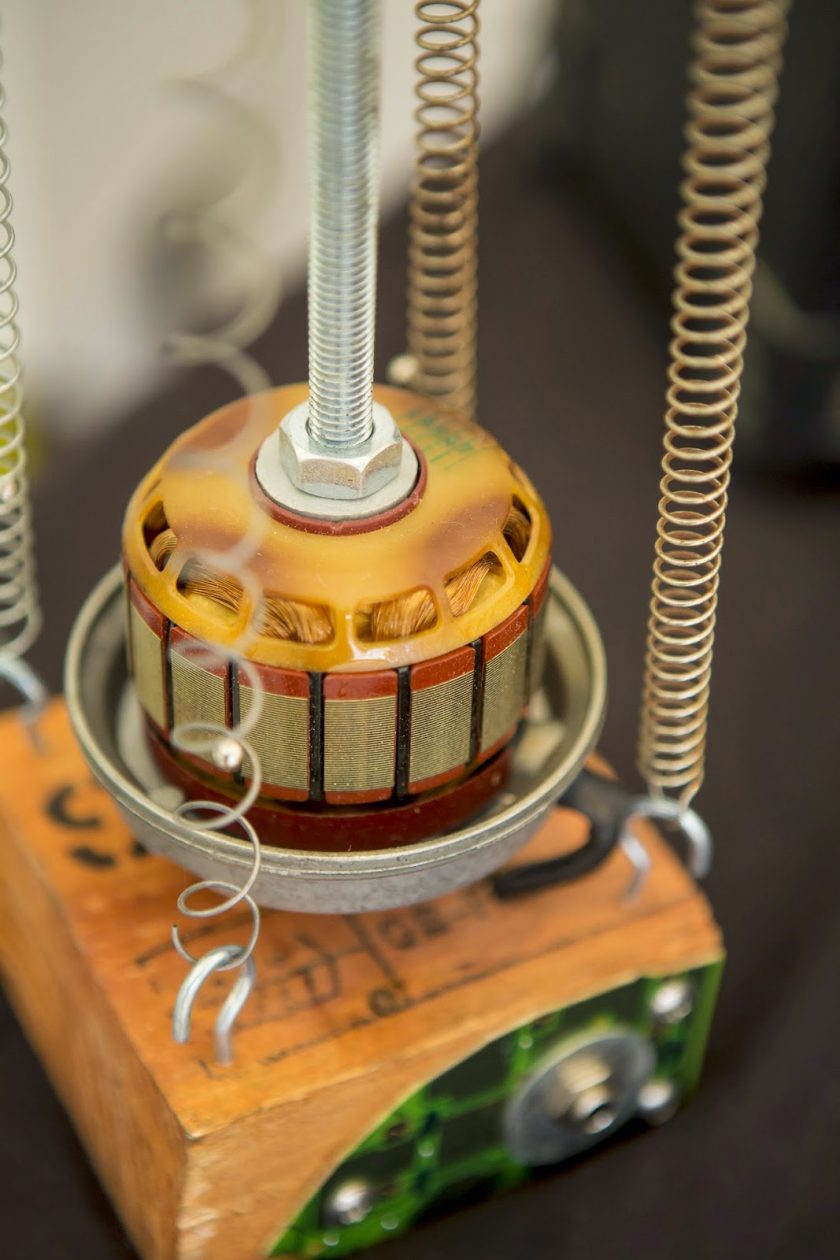
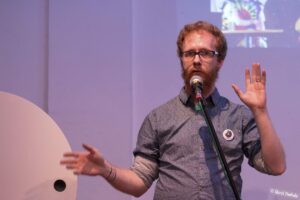
Tom Fox uses recycled and reclaimed materials to make musical instruments, sound machines and interactive installations. He has performed or talked at The Tate Modern, The Royal College of Music, The Royal College of Art, and many European music tech festivals. I interviewed Tom about what goes into his performances, his vulpestruments and his organisation Hackoustic – a London-based group that promotes original sound artists, music technologists and instrument builders.
Leslie: Can you tell us about the simplest instruments you build, please.
Tom: The simplest instrument I designed is literally a Pringles tube, a string and a pencil! It can take a lot of effort to make something simple, so one challenge I set myself was to create the simplest, tuneable stringed instrument possible. And I don’t think I can get simpler than 3 components. It is a great one to build with kids as it is so simple but explains how tension is used to control pitch. You can pluck it and pitch bend it and play it a bit like an Indian Ektara.
Leslie: How have you extended your basic range into more complex instruments?
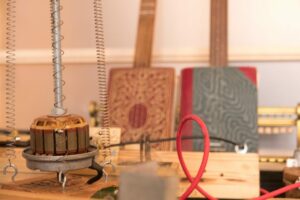 Tom: My more complex instruments include streaming data from Twitter and converting it into messages via python coding which then gets translated into MIDI data which then controls a DADAmachines Automat which converts the MIDI into electrical signals which triggers solenoids connected to an array of physical instruments. So a little more complex than a pringles tube a string and a pencil! I introduced technology into my instruments to reach a more interesting level of interaction. I wanted to explore how I can have anyone of any ability be able to play music or make sounds. Using sensors and microcontrollers or data streams really opened up those possibilities.
Tom: My more complex instruments include streaming data from Twitter and converting it into messages via python coding which then gets translated into MIDI data which then controls a DADAmachines Automat which converts the MIDI into electrical signals which triggers solenoids connected to an array of physical instruments. So a little more complex than a pringles tube a string and a pencil! I introduced technology into my instruments to reach a more interesting level of interaction. I wanted to explore how I can have anyone of any ability be able to play music or make sounds. Using sensors and microcontrollers or data streams really opened up those possibilities.
Leslie: Why do you build new instruments? What sound universes are you trying to explore?
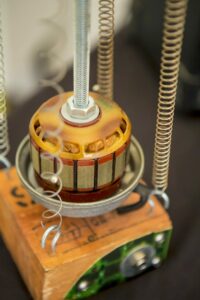
Tom: I started building instruments just as a hobby as I loved playing music and had ideas for instruments I wanted but couldn’t afford. This led to me using reclaimed or recycled materials in my builds so that I wouldn’t waste money or resources. This limitation to ONLY reclaimed materials forced me to be way more creative with what I was building. So I started experimenting with reclaimed electronics and playing with physics to create sounds which opened up a whole new world of sound making for me. Now, I tend to focus on exploring interactivity and accessibility in music, so either interesting or unique methods of playing instruments or new ways to interact with sound. The instruments definitely induce a sense of awe and wonder when people see them being played. They tend to look NOTHING like regular instruments and so when these unique sounds start being made it sparks a lot of curiosity in people.
Leslie: Why do you focus on stringed instruments?
Tom: I focus on stringed things as they tend to be easier to construct and you can get a lot of variation in sounds and textures from just a few strings. You need to keep in mind that strings hold a lot of tension and can easily bend and break structures if they’re not strong enough! I tend to overcompensate and use chunky hardwoods or align the strings along the strongest grain of the wood. There are a few other little tips and tricks like making sure strings don’t dig into wood and using ridged bridges and nuts to keep strings separated. A lot of my knowledge comes from getting it wrong and having things not work, I always think failing is an important thing to do!
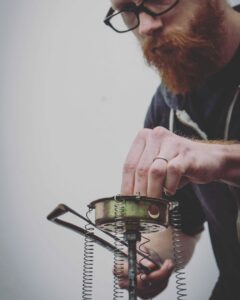 Leslie: Where do your ideas come from for developing new instruments?
Leslie: Where do your ideas come from for developing new instruments?
Tom: Ideas can come from anywhere! I might see some interesting mechanical movement and decide to explore that as a method of playing a string, I might find a nice sounding box or an unusual piece of electronics and explore how it might make sounds. One thing I enjoy doing is what I call organic building. So I will gather together a bunch of components that I know will make noises when they interact with each other, and find a way to construct them into one instrument and see how it sounds. Sometimes it works and sometimes it doesn’t! Sometimes I will think of a particular scenario where I’d like to have musical interactions, and will have to then research the steps necessary to make it happen. No instrument has a definite plan when I start building it and evolves as I’m building or developing it.
Leslie: You teach people how to build and use these instruments. What’s that like?
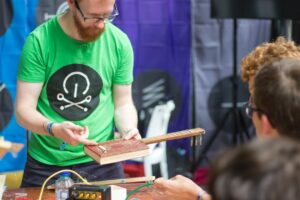
Tom: My favourite moments from the teaching aspect is when I use instruments to explain Faraday’s laws of electromagnetic Induction. It’s quite an important part of physics and demonstrating it in a new and unique way has made people suddenly realise they understand how it works. When I run workshops for kids it is always a wonderful thing seeing them beaming with joy that they made something and that it works and can play music.
Leslie: Can you give a few examples, please, that illustrate all the differences and similarities between your instruments and your installations?
Tom: My instruments come about in two ways, either somebody commissions me to create something for them that they would then use in their studio of for their own performances, so these ones are very personal and customised for that person. Or I make something for myself to either see if it works that I can use to perform with. My installations are much more focused creations that has a specific user in mind with the design. So usually they are in events with the general public with a wide range of musical ability, so I try to make them in a way that anybody can approach them and play them. Their similarities include using pretty unusual ways of creating sounds and noises and textures.
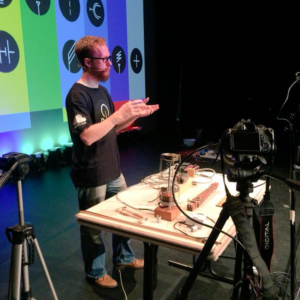
Leslie: Can you describe the contribution other people have made to vulpestruments and the collective side of your work?
Tom: The collective side of my work is a very important one! I am the creative director of Hackoustic, alongside my wife Stephanie Fox and artist Tim Yates. We run events and workshops and curate parts of larger festivals in London, to showcase other artists and musicians who explore sound and instrument making. We have been doing this around London for 5 years now and have been involved with a few events at the Tate modern, V&A museum, Institute of Imagination and recently we helped organise the first ever hackathon at Abbey Road studios! The community that has built up around us has led to artists meeting and collaborating and gaining more confidence in their own work: it’s been a hugely rewarding experience! The other fantastic community I am a part of is Music Tech Fest, which is a more global scale and more advanced technology. I’ve been part of the organising team for them for a few years now working on running events in places like Stockholm, Frankfurt, Genova and Liege. I definitely didn’t think I would be getting these experiences and opportunities when I started making basic instruments from scrap wood and nails!
Leslie: What kind of beauty are you striving to create with vulpestruments?
Tom: I guess the thing I’m hoping to do most is inspire curiosity in other people and then also giving them the knowledge and tools to create their own ideas. I’m a big believer in open-source knowledge, so I write tutorials on how I do things and I get emails from people asking for advice which I always do my best to help with. If I can give other people the confidence to experiment and create their own musical creations then I’ll be happy!
Next week Niamh Calderwood talks about acting, writing, transitioning in Sunderland and living with an awareness of climate breakdown.
ABOUT LESLIE TATE’S BOOKS:

I interviewed writer Julia Lee Barclay-Morton about her experience of autism. Julia began as an experimental dramatist in New York, moving to the UK to

I interviewed Gillean McDougall from Glasgow, who edited the collaborative projects Honest Error (on Charles Rennie Mackintosh and his wife Margaret Macdonald) and Writing the

I interviewed French writer Delphine de Vigan, whose book, No et moi, won the prestigious Prix des libraires. Other books of hers have won a clutch

I interviewed Joanne Limburg whose poetry collection Feminismo was shortlisted for the Forward Prize for Best First Collection; another collection, Paraphernalia, was a Poetry Book Society Recommendation. Joanne

I interviewed Katherine Magnoli about The Adventures of KatGirl, her book about a wheelchair heroine, and Katherine’s journey from low self-esteem into authorial/radio success and
| Cookie | Duration | Description |
|---|---|---|
| cookielawinfo-checkbox-analytics | 11 months | This cookie is set by GDPR Cookie Consent plugin. The cookie is used to store the user consent for the cookies in the category "Analytics". |
| cookielawinfo-checkbox-functional | 11 months | The cookie is set by GDPR cookie consent to record the user consent for the cookies in the category "Functional". |
| cookielawinfo-checkbox-necessary | 11 months | This cookie is set by GDPR Cookie Consent plugin. The cookies is used to store the user consent for the cookies in the category "Necessary". |
| cookielawinfo-checkbox-others | 11 months | This cookie is set by GDPR Cookie Consent plugin. The cookie is used to store the user consent for the cookies in the category "Other. |
| cookielawinfo-checkbox-performance | 11 months | This cookie is set by GDPR Cookie Consent plugin. The cookie is used to store the user consent for the cookies in the category "Performance". |
| viewed_cookie_policy | 11 months | The cookie is set by the GDPR Cookie Consent plugin and is used to store whether or not user has consented to the use of cookies. It does not store any personal data. |